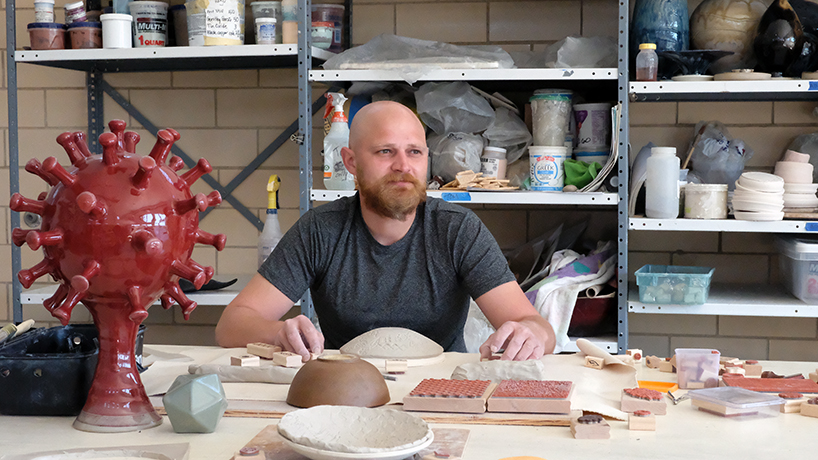
Biochemistry and biotechnology student Thomas Perrot has combined his dual interests of ceramics and science while at UMSL. One example is the clay model of the COVID-19 virus (at left) that Perrot created for the 2020 Undergraduate Research Symposium. (Photo by Jessica Rogen)
After a few years working at a scientific equipment certification company, Thomas Perrot realized his interest in the selling and administration of the equipment had faded.
He was much more intrigued by the underlying science and its applications.
Perrot quit that job, found one with UPS and enrolled in the Biochemistry and Biotechnology Program at the University of Missouri–St. Louis with the idea that he’d take courses and work simultaneously. He thought he’d better ease into school and signed up for ceramics with UMSL faculty member Snail Scott.
“It was just to get comfortable with the campus,” Perrot said. “Ceramics is a perfect opportunity to get out of your head and work with your hands.”
Though Perrot hadn’t touched clay since he was 16 years old, he soon found himself back in the rhythm of it. Before long, he found himself on an unexpected path.
Now, with just one three-credit class left to finish over the summer, Perrot is poised to graduate with feet planted in both the arts and the sciences. While in school, he’s not only thrived in biochemistry and biotechnology – participating in Professor of Chemistry and Biochemistry James Bashkin’s lab and in UMSL’s Undergraduate Research Symposium – but also worked at ceramics workshop LampLight Studio.
Initially, the transition from work to academia proved to be an adjustment for Perrot. His first science class at UMSL was “Biology: From Molecules to Organisms,” taught by Assistant Teaching Professor Christopher Wolin.
“That class was a shock to me,” he said. “I was catching up. I was never into science in high school, but I just became infatuated with it.”
Wolin turned out to be a difficult teacher but was very accessible for his students. Perrot attended additional Friday afternoon workshops and lessons, working harder than he ever had before.
That effort paid off with an A.
“It felt awesome,” he said, explaining he’d continued on through the program, checking off biology and chemistry classes until he hit the big one – organic chemistry – a notoriously difficult course.
That’s when things really clicked. Suddenly, Perrot became absorbed in the shapes of molecules and the way they interact with each other.
“Organic chemistry was it,” he said. “I was like, ‘I can do this for a living.’”
That class also opened up a door to undergraduate research.
The instructor, Bashkin, invited Perrot to join his chemical genomics lab. Bashkin’s research focuses on developing molecules that bind to DNA and can help treat or diagnose diseases, and his recent focus has been on cervical cancer and Human Papilloma Virus.
“These viruses hijack your machinery,” Perrot said. “We made these molecules that would stop HPV from successfully replicating. They were all novel polyamines.”
Unfortunately, before Perrot and others could test their novel compounds, precautions to stop the spread of COVID-19 sent them all home.
But that wasn’t the extent of Bashkin’s influence on Perrot. He took inspiration from his experiences in the lab and brought them to the ceramics studio.
In 2018, Perrot decided he’d combine his passions for UMSL’s Undergraduate Research Symposium and create a 4-foot-tall bacteriophage for the event’s “other” category. The next year, he made an HPV virus, and then in 2020, Perrot modeled the COVID-19 virus.
That’s not the only time that Perrot’s passions for ceramics and science have overlapped. One finals week, he noticed Teaching Professor Michael Fix drinking out of a handmade clay mug. The two got to talking, and Fix revealed that he had 200 pounds of clay from an archeological dig.
“I processed all the clay,” Perrot said, pulling out a bucket of what appears to be gravel and bones that he’d removed from it. “This is what was in it, so I’m hoping there’s some dinosaur bones.”
The easy mesh of the two disciplines in his life isn’t as odd as it might appear, Perrot said, because they aren’t that different.
“Ceramics is one big chemistry equation,” he said. “We’ve got organic dirt, rocks, and then we raise the temperature to 2,000 degrees, and the molecules reorganize to form a crystal structure, so there’s a lot of science that goes into it.”
Throughout school, Perrot has worked as a sort of shop assistant at LampLight – cutting the grass, teaching night classes and helping out where needed. Through his association with the studio, he’s also become involved with Blaze STL, an education and occupational program that partners with area nonprofits to provide support for the disadvantaged and disabled in the greater St. Louis area.
“We’re losing this affiliation with our working with our hands,” Perrot said. “We’re so caught up in our head and computers and screens, and it’s so important to have some place to decompress.”
As school begins to wind down for Perrot, he’s put some thought into what he’d like to do long term and hopes to eventually work in agriculture looking at food supplies. But in the short term, he has a job lined up helping a friends’ logistics company get started.
Regardless of what happens in the future, Perrot will have favorite aspects of his time at UMSL to look back upon, including the community and friends he’s made through both the sciences and the arts. One unexpected surprise to school has been the opportunity to meet many people whose experiences have been unlike his own.
“There’s a nice little community in the sciences,” he said, reflecting on making friends with students from Vietnam, Iraq, Russia and Afghanistan. “I feel like if I would walk up to Dr. Linda McDowell‘s class or Dr. Wolin’s, they would know me by name. That’s important. It’s just been a really good experience for me.”














